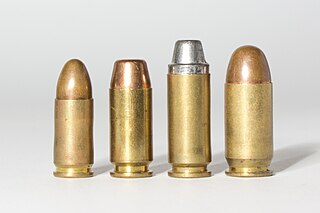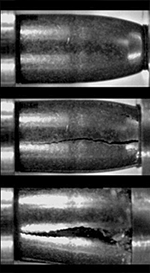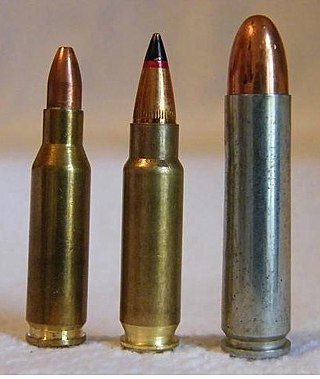
The 5.56×45mm NATO is a rimless bottlenecked intermediate cartridge family developed in the late 1970s in Belgium by FN Herstal. It consists of the SS109, L110, and SS111 cartridges. On 28 October 1980, under STANAG 4172, it was standardized as the second standard service rifle cartridge for NATO forces as well as many non-NATO countries. Though they are not entirely identical, the 5.56×45mm NATO cartridge family was derived from and is dimensionally similar to the .223 Remington cartridge designed by Remington Arms in the early 1960s.

A bullet is a kinetic projectile, a component of firearm ammunition that is shot from a gun barrel. They are made of a variety of materials, such as copper, lead, steel, polymer, rubber and even wax; and are made in various shapes and constructions, including specialized functions such as hunting, target shooting, training, and combat. Bullets are often tapered, making them more aerodynamic. Bullet size is expressed by weight and diameter in both imperial and metric measurement systems. Bullets do not normally contain explosives but strike or damage the intended target by transferring kinetic energy upon impact and penetration.

A hollow-point bullet is a type of expanding bullet which expands on impact with a soft target, transferring more or all of the projectile's energy into the target over a shorter distance.

A cartridge, also known as a round, is a type of pre-assembled firearm ammunition packaging a projectile, a propellant substance and an ignition device (primer) within a metallic, paper, or plastic case that is precisely made to fit within the barrel chamber of a breechloading gun, for convenient transportation and handling during shooting. Although in popular usage the term "bullet" is often used to refer to a complete cartridge, the correct usage only refers to the projectile.

Terminal ballistics is a sub-field of ballistics concerned with the behavior and effects of a projectile when it hits and transfers its energy to a target.

Expanding bullets, also known colloquially as dumdum bullets, are projectiles designed to expand on impact. This causes the bullet to increase in diameter, to combat over-penetration and produce a larger wound, thus dealing more damage to a living target. For this reason, they are used for hunting and by most police departments, but are generally prohibited for use in war. Two typical designs are the hollow-point bullet and the soft-point bullet.

A soft-point bullet (SP), also known as a soft-nosed bullet, is a jacketed expanding bullet with a soft metal core enclosed by a stronger metal jacket left open at the forward tip. A soft-point bullet is intended to expand upon striking flesh to cause a wound diameter greater than the bullet diameter. Jacketed soft point bullets are usually abbreviated JSP in the ammunition and reloading industry. The use of soft-point bullets in warfare is a violation of the Hague Convention of 1899, declaration IV, 3.

The 9×19mm Parabellum is a rimless, centerfire, tapered firearms cartridge.

The .22 Long Rifle, also known as the .22LR or 5.6×15mmR, is a long-established variety of .22 caliber rimfire ammunition originating from the United States. It is used in a wide range of firearms including rifles, pistols, revolvers, and submachine guns.
The .30-06 Springfield cartridge, 7.62×63mm in metric notation, and called the .30 Gov't '06 by Winchester, was introduced to the United States Army in 1906 and later standardized; it remained in military use until the late 1970s. In the cartridge's name, ".30" refers to the nominal caliber of the bullet in inches; "06" refers to the year the cartridge was adopted, 1906. It replaced the .30-03 Springfield, 6mm Lee Navy, and .30-40 Krag cartridges. The .30-06 remained the U.S. Army's primary rifle and machine gun cartridge for nearly 50 years before being replaced by the 7.62×51mm NATO and 5.56×45mm NATO, both of which remain in current U.S. and NATO service. The cartridge remains a very popular sporting round, with ammunition produced by all major manufacturers.

The .303 British or 7.7×56mmR, is a .303-inch (7.7 mm) calibre rimmed tapered rifle cartridge. The .303 inch bore diameter is measured between rifling lands as is the common practice in Europe which follows the traditional black powder convention.
Obturation is the necessary barrel blockage or fit in a firearm or airgun created by a deformed soft projectile. A bullet or pellet made of soft material and often with a concave base will flare under the heat and pressure of firing, filling the bore and engaging the barrel's rifling. The mechanism by which an undersized soft-metal projectile enlarges to fill the barrel is, for hollow-base bullets, expansion from gas pressure within the base cavity and, for solid-base bullets, "upsetting"—the combined shortening and thickening that occurs when a malleable metal object is struck forcibly at one end.
The 5.45×39mm cartridge is a rimless bottlenecked intermediate cartridge. It was introduced into service in 1974 by the Soviet Union for use with the new AK-74. The 5.45×39mm gradually supplemented and then largely replaced the 7.62×39mm cartridge in Soviet and Warsaw Pact service as the primary military service rifle cartridge.

The 7.5×55mm Swiss or 7,5mm GP 11 is a cartridge developed for the Swiss Army. It originated from the Gewehrpatrone 1890 (7.5×53.5mm) developed in 1898 by mechanical engineer Lt. Col. Eduard Rubin for rifles based on Rudolf Schmidt's action design. The 7.5×55mm Swiss GP 11 cartridge is similar in appearance to the slightly smaller 7.5×54mm French round though the two are not interchangeable.

Frangible bullets are intended to disintegrate into tiny particles upon target impact to minimize their penetration of other objects. Small particles are slowed more rapidly by air resistance, and are less likely to cause injury or damage to persons and objects distant from the point of bullet impact.

A gas check is a gasket type component of firearms ammunition. Gas checks are used when non-jacketed bullets are used in high pressure cartridges. The use of a gas check inhibits the buildup of lead in the barrel and improves accuracy.

The spitzer bullet is a pointed projectile that is primarily used in small-arms. The pointed nose shape, which was developed for military purposes in the late 19th and early 20th century, was a major design improvement compared to earlier rounder or flatter-tipped bullets because pointed nose shapes were less susceptible to external ballistic factors like drag. By adding a point, projectiles made for fully-powered and intermediate rifle cartridges obtain a lower drag coefficient, which makes them decelerate less rapidly. Lowering the drag coefficient leads to improved external ballistic behaviour.
The following are terms related to firearms and ammunition topics.

A cast bullet is made by allowing molten metal to solidify in a mold. Most cast bullets are made of lead alloyed with tin and antimony; but zinc alloys have been used when lead is scarce, and may be used again in response to concerns about lead toxicity. Most commercial bullet manufacturers use swaging in preference to casting, but bullet casting remains popular with handloaders.

The 4.6×30mm cartridge is a small-caliber, high-velocity, smokeless powder, rebated, bottleneck, centerfire cartridge designed for personal defense weapons (PDW) developed by German armament manufacturer Heckler & Koch (HK) in 1999. It was designed primarily for the MP7 PDW to minimize weight and recoil, while increasing penetration of body armor. It features a pointed, steel-core, brass-jacketed bullet.

















